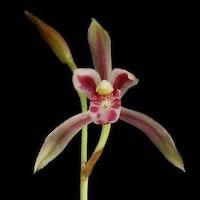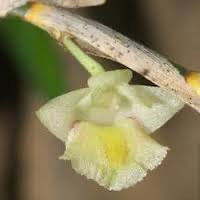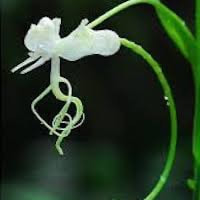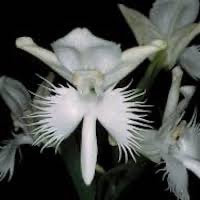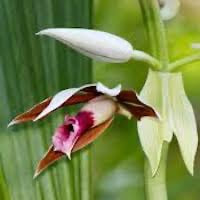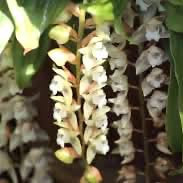WFL10 - Women's Floral 10 - Cleopatra's
|
Native Singaporean Orchid notes: Zygopetalum Blackii
Zygopetalum Blackii, used in the Floral 10 (Women) perfume workshop for team building, is a compact hybrid orchid valued for its enchanting scent similar to hyacinth with a hint of pepperiness in the afternoon. Known for its long-lasting flowers, which bloom for 2-3 months, this orchid displays green and brown hues with striking stripes or speckles and a broad white velvety lip in shades of purple, indigo, maroon, or fuchsia. Its beauty and unique fragrance make it a standout member of the Zygopetalum family.
|
Therapeutic Orchid notes:
|
Cymbidium macrorhizon Lindl.
Cymbidium macrorhizon Lindl. is an orchid found along rivers, at forest edges, and on grassy slopes from southern China to Pakistan. Known for its medicinal properties, its rhizomes are used in traditional herbal medicine in northern India. These rhizomes act as diaphoretics to promote sweating and febrifuges to reduce fever. They are also used to treat boils and rheumatism. This orchid’s therapeutic uses highlight its importance in traditional remedies across its natural habitat. |
|
Dendrobium acinaciforme Roxb syn. D. spatella Rchb.f, D. banaense Gagn.,
Dendrobium acinaciforme, also known as Jianye Shihu in Chinese and Uang Takhap in Thai, is a versatile orchid found across Southeast Asia and parts of China. It grows naturally in regions from northern Thailand to south China and the Malay Peninsula. In traditional Chinese medicine, this orchid is used as a tonic to help with illness recovery. It is believed to reduce fever, quench thirst, alleviate tiredness, and relieve general discomfort. Its medicinal uses highlight its value in traditional healing practices. |
|
Habenaria commelinifolia (Roxb.) Wall ex Lindl.
Habenaria commelinifolia, known as Fueyufeng hua in Chinese, Devsunda or Jadu in India, Jaitjadu in Sadani, and Kadaw sut in Myanmar, is an orchid species with various traditional uses. The plant is eaten as a vegetable and is believed to purify the blood and treat palm blebs. In India, its dried root is used for spermatorrhoea, and its bark is thought to have estrogenic effects, promoting women’s health and treating gynecological conditions. This orchid's diverse applications highlight its significance in traditional medicine. |
|
Pecteilis susannae (L.) Raf. syn. Habenaria susannae (L.) R. Br.
Pecteilis susannae, known as Longtou Lan or dragon head orchid in Chinese and Riddhi Vriddhi in India, is a large orchid found in regions like Pakistan, India, Myanmar, and China. In Traditional Chinese Medicine, its roots are used to support kidney health, strengthen yang energy, and benefit the spleen. In India, the pseudobulbs treat conditions like backache, impotence, and indigestion, and are used to make a medicinal drink called Salep. This orchid is valued for its medicinal properties and traditional uses. |
|
Phaius tankervilleae (Banks) Blume
Phaius tankervilleae, also known as Honghe Lan (red crane orchid) in Chinese and Angkrek apuj (fire orchid) in Indonesian, is a versatile orchid found in Southeast Asia and the Pacific Islands. Its pseudobulbs are sun-dried for traditional medicine, where they are used to treat fever, detoxify the body, and prevent coughs. In India, the bulbs help with fractures and dysentery, while in Malaysia, they heal wounds. The orchid's flowers are also used in Papua New Guinea for fertility and contraception. Phaius tankervilleae contains alkaloids like phytanthrin A with potential cancer-fighting properties. |
|
Pholidota chinensis Lindl.
Pholidota chinensis, also known as Datiao Lan (large hanging orchid) in Chinese and Kwyet mee pan myo kywe in Myanmar, is an epiphytic orchid found in East Asia and Southeast Asia. The plant, with its creeping rhizome, thrives on tree trunks and rocks in forests. In traditional medicine, Pholidota chinensis is used for a variety of ailments, including tuberculosis, coughs, and toothaches. It contains compounds like bulbophylol B, which may help reduce inflammation, and batatasin III, which can relieve pain. The diverse medicinal applications highlight its importance in traditional herbal practices. |
Other scent note
Leafy sweet florals; Middle notes of jasmine, Sweet pea, Hyssop, and white floral; base of floral musk.
Scentopia Library Reference ingredient
Primrose - Check details at Scentopia's scent library
Download the guided mediation that works best with this Orchid fragrance oil
| women_floral_essential_oil_orchi_00010.mp3 | |
| File Size: | 192251 kb |
| File Type: | mp3 |

